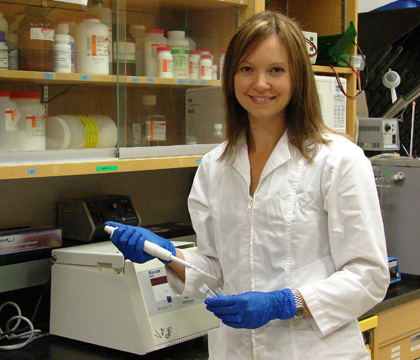
Diagnostic precision for pancreatic cancer
Feline pancreatic adenocarcinoma is a rare and fatal malignant cancer of the pancreas in cats. Symptoms of the disease appear very similar to pancreatitis and are generally non-specific, making it a challenge to diagnose.
By Robyn Thrasher
"In some cases, it can be difficult to establish a diagnosis before death," says Dr. Melissa Meachem, a Western College of Veterinary Medicine (WCVM) graduate student working towards her PhD in veterinary pathology.
Typically affecting middle-aged to older cats, pancreatic adenocarcinoma causes lethargy, a loss of appetite and weight loss. According to medical oncologist Dr. Valerie MacDonald, the outcome for this cancer is very poor due to its location and advanced stage of disease at the time of diagnosis.
"Treatment options are limited and strictly palliative," says MacDonald, an associate professor at the WCVM. "Chemotherapy doesn't usually extend survival time, but it can sometimes make the patient feel better. One year survival, regardless of treatment, has not been reported."
Analyzing a biopsy sample of pancreatic tissue is the gold standard for diagnosis, but sample collection requires general anesthetic which can be risky for these very ill cats. An ultrasound exam may also detect a pancreatic mass — another potential indication of pancreatic cancer.
For her Master of Veterinary Science (MVetSc) research project, Meachem wanted to search for a more accurate and less invasive method to diagnose pancreatic cancer in cats.
While in private practice, Meachem learned firsthand how tough it was to diagnose and care for feline patients with suspected pancreatitis.
"Some of these cats were really sick and not recovering so I began to wonder about the potential for underlying pancreatic cancer," says Meachem, who graduated from the WCVM in 2008.

"Without access to advanced diagnostics, it really made me think that it would be nice to have a test that was easily accessible by all practitioners that could clearly distinguish between pancreatitis and pancreatic adenocarcinoma."
Meachem's study, supported by the WCVM's Companion Animal Health Fund (CAHF), involved the use of proteomics – the study of the structures and functions of proteins.
The proteome is conceptually similar to the genome: while the genome refers to all of the genes in the body, the proteome includes all of the protein expressed in the body.
"One of the exciting aspects of proteomics is that once proteins are synthesized, they can be modified according to different conditions," explains Meachem. "Therefore, the proteome of an animal can be influenced by different disease states."
The objective of Meachem's study was to characterize the proteome of a cat with pancreatic adenocarcinoma and compare it to the proteome of a healthy cat or a cat with pancreatitis with the goal of revealing potential diagnostic indicators — known as biomarkers — for pancreatic cancer.
In 2009, Meachem started collecting clinical cases of pancreatitis and pancreatic adenocarcinoma with the help of Dr. Elisabeth Snead, a WCVM associate professor in small animal medicine.
"We reached out to all of the small animal clinics and referral centres in Western Canada," explains Meachem, whose work was supervised by WCVM veterinary pathologist Dr. Elemir Simko.
Once a clinician identified a cat with either condition, blood plasma samples were collected and sent to Meachem.
After gathering plasma samples from six cats with pancreatic adenocarcinoma, six cats with pancreatitis and six healthy age-matched cats, Meachem created a protein profile using a technique called two-dimensional sodium dodecyl sulfate polyacrylamide gel electrophoresis (2D SDS PAGE).
"Every protein has a unique charge or iso-electric point based on its amino acid structure," she explains. "2D SDS PAGE separates out all the proteins based on their iso-electric point then separates them in the second dimension based on their molecular size."
The gels were stained to visualize the various proteins and comparatively analyzed using specialized computer software.
Meachem found that three proteins were fairly consistently different between the study groups. She used liquid chromatography mass spectrometry to identify these proteins as apolipoprotein A-1, haptoglobin and α1-acid glycoprotein.
"Haptoglobin and α1-acid glycoprotein are acute phase proteins that increase with inflammation," says Meachem. "Unfortunately, these proteins are not tumour specific and any type of inflammation can potentially cause them to increase."
However, she adds that there appeared to be some differences in the degree with which these biomarkers increased with cancer in comparison to cats with pancreatitis.
"In a clinical situation, if these proteins are greatly elevated in a cat with suspected pancreatitis then it may lead the clinician to consider further investigation into the possibility of cancer."
Apolipoprotein A-1 is a major component of high density lipoprotein (HDL) in cats and is involved in reverse cholesterol transport – a process where excess cholesterol in tissues is brought back to the liver. This suggests that lipid metabolism may be affected in cats with these tumours.
With the results of this study, Meachem hopes to develop a diagnostic blood panel that combines these protein biomarkers to aid in earlier and more precise diagnosis of pancreatic cancer.
"It's still a work in progress," she says. "To this day I continue to accumulate more cases to strengthen my data."
For future research, Meachem plans to investigate a more sensitive laboratory technique for mapping the proteome.
"There may be additional biomarkers that we're not aware of yet because our current technique isn't able to detect proteins present in smaller quantities."
Meachem also intends to explore biomarkers that are being looked at for detecting human pancreatic disease.
"A number of human studies using the same proteomic techniques have found similar changes, especially with the acute phase proteins," she says. "There have been some research-based trials using these biomarkers in a diagnostic panel that have shown fairly good sensitivity and specificity, but nothing is in routine use yet. Everything's still very experimental."
Robyn Thrasher of Edmonton, Alta., is a third-year veterinary student at the WCVM. Robyn is a WCVM research communications intern as well as a summer student in the WCVM Veterinary Medical Centre during the summer of 2012.
Typically affecting middle-aged to older cats, pancreatic adenocarcinoma causes lethargy, a loss of appetite and weight loss. According to medical oncologist Dr. Valerie MacDonald, the outcome for this cancer is very poor due to its location and advanced stage of disease at the time of diagnosis.
"Treatment options are limited and strictly palliative," says MacDonald, an associate professor at the WCVM. "Chemotherapy doesn't usually extend survival time, but it can sometimes make the patient feel better. One year survival, regardless of treatment, has not been reported."
Analyzing a biopsy sample of pancreatic tissue is the gold standard for diagnosis, but sample collection requires general anesthetic which can be risky for these very ill cats. An ultrasound exam may also detect a pancreatic mass — another potential indication of pancreatic cancer.
For her Master of Veterinary Science (MVetSc) research project, Meachem wanted to search for a more accurate and less invasive method to diagnose pancreatic cancer in cats.
While in private practice, Meachem learned firsthand how tough it was to diagnose and care for feline patients with suspected pancreatitis.
"Some of these cats were really sick and not recovering so I began to wonder about the potential for underlying pancreatic cancer," says Meachem, who graduated from the WCVM in 2008.

"Without access to advanced diagnostics, it really made me think that it would be nice to have a test that was easily accessible by all practitioners that could clearly distinguish between pancreatitis and pancreatic adenocarcinoma."
Meachem's study, supported by the WCVM's Companion Animal Health Fund (CAHF), involved the use of proteomics – the study of the structures and functions of proteins.
The proteome is conceptually similar to the genome: while the genome refers to all of the genes in the body, the proteome includes all of the protein expressed in the body.
"One of the exciting aspects of proteomics is that once proteins are synthesized, they can be modified according to different conditions," explains Meachem. "Therefore, the proteome of an animal can be influenced by different disease states."
The objective of Meachem's study was to characterize the proteome of a cat with pancreatic adenocarcinoma and compare it to the proteome of a healthy cat or a cat with pancreatitis with the goal of revealing potential diagnostic indicators — known as biomarkers — for pancreatic cancer.
In 2009, Meachem started collecting clinical cases of pancreatitis and pancreatic adenocarcinoma with the help of Dr. Elisabeth Snead, a WCVM associate professor in small animal medicine.
"We reached out to all of the small animal clinics and referral centres in Western Canada," explains Meachem, whose work was supervised by WCVM veterinary pathologist Dr. Elemir Simko.
Once a clinician identified a cat with either condition, blood plasma samples were collected and sent to Meachem.
After gathering plasma samples from six cats with pancreatic adenocarcinoma, six cats with pancreatitis and six healthy age-matched cats, Meachem created a protein profile using a technique called two-dimensional sodium dodecyl sulfate polyacrylamide gel electrophoresis (2D SDS PAGE).
"Every protein has a unique charge or iso-electric point based on its amino acid structure," she explains. "2D SDS PAGE separates out all the proteins based on their iso-electric point then separates them in the second dimension based on their molecular size."
The gels were stained to visualize the various proteins and comparatively analyzed using specialized computer software.
Meachem found that three proteins were fairly consistently different between the study groups. She used liquid chromatography mass spectrometry to identify these proteins as apolipoprotein A-1, haptoglobin and α1-acid glycoprotein.
"Haptoglobin and α1-acid glycoprotein are acute phase proteins that increase with inflammation," says Meachem. "Unfortunately, these proteins are not tumour specific and any type of inflammation can potentially cause them to increase."
However, she adds that there appeared to be some differences in the degree with which these biomarkers increased with cancer in comparison to cats with pancreatitis.
"In a clinical situation, if these proteins are greatly elevated in a cat with suspected pancreatitis then it may lead the clinician to consider further investigation into the possibility of cancer."
Apolipoprotein A-1 is a major component of high density lipoprotein (HDL) in cats and is involved in reverse cholesterol transport – a process where excess cholesterol in tissues is brought back to the liver. This suggests that lipid metabolism may be affected in cats with these tumours.
With the results of this study, Meachem hopes to develop a diagnostic blood panel that combines these protein biomarkers to aid in earlier and more precise diagnosis of pancreatic cancer.
"It's still a work in progress," she says. "To this day I continue to accumulate more cases to strengthen my data."
For future research, Meachem plans to investigate a more sensitive laboratory technique for mapping the proteome.
"There may be additional biomarkers that we're not aware of yet because our current technique isn't able to detect proteins present in smaller quantities."
Meachem also intends to explore biomarkers that are being looked at for detecting human pancreatic disease.
"A number of human studies using the same proteomic techniques have found similar changes, especially with the acute phase proteins," she says. "There have been some research-based trials using these biomarkers in a diagnostic panel that have shown fairly good sensitivity and specificity, but nothing is in routine use yet. Everything's still very experimental."
Robyn Thrasher of Edmonton, Alta., is a third-year veterinary student at the WCVM. Robyn is a WCVM research communications intern as well as a summer student in the WCVM Veterinary Medical Centre during the summer of 2012.
